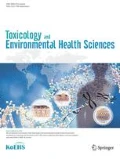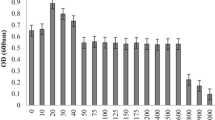Abstract
Biodegradation of the anti-inflammatory drug Diclofenac (DCF) was studied using Enterobacter cloacae (D16) isolated from household compost. This isolate was able to eliminate 67.57% of DCF as sole carbon source after 48 h of incubation. Parallel to its disappearance, five metabolites were observed in microbial active samples which were suspected to be the DCF metabolites. GCMS showed a very similar spectrum of these metabolites with the MS spectrum of the parent compound. DCF Toxicity at different concentrations (toxic dose, therapeutic dose, and low dose) and its metabolites toxicity toward mice liver cells were evaluated. At toxic and therapeutic doses DCF had a negative effect on the oxidative stress parameters represented by a decrease in Reduced Glutathione reserve, lipid peroxidation and a disturbance of the liver detoxification enzymes (superoxide dismutase, Catalase, and glutathione S-transferase). In contrast, no effect was observed after treatment of animals with low dose and DCF biotransformation products.
Similar content being viewed by others
References
Tran, N. H., Urase, T., Ngo, H. H., Hu, J. & Ong, S. L. Insight into metabolic and cometabolic activities of autotrophic and heterotrophic microorganisms in the biodegradation of emerging trace organic contaminants. Bioresour. Technol. 146, 721–731 (2013).
Kosjek, T., Heath, E. & Kompare, B. Removal of pharmaceutical residues in a pilot wastewater treatment plant. Anal. Bioanal. Chem. 387, 1379–1387 (2007).
Schmitt-Jansen, M., Bartels, P., Adler, N. & Altenburger, R. Phytotoxicity assessment of diclofenac and its phototransformation products. Anal. Bioanal. Chem. 387, 1389–1396 (2007).
González-Mariño, I., Quintana, J. B., Rodríguez, I. & Cela, R. Determination of drugs of abuse in water by solid-phase extraction, derivatisation and gas chromatography-ion trap-tandem mass spectrometry. J. Chromatogr. A 1217, 1748–1760 (2010).
Marco-Urrea, E., Pérez-Trujillo, M., Cruz-Morató, C., Caminal, G. & Vicent, T. Degradation of the drug sodium diclofenac by Trametes versicolor pellets and identification of some intermediates by NMR. J. Hazard. Mater. 176, 836–842 (2010).
Forrez, I., Boon, N., Verstraete, W. & Carballa, M. in Comprehensive biotechnology (Elsevier, Netherlands, 2011).
Quinn, B., Schmidt, W., O’Rourke, K. & Hernan, R. Effects of the pharmaceuticals gemfibrozil and diclofenac on biomarker expression in the zebra mussel (Dreissena polymorpha) and their comparison with standardised toxicity tests. Chemosphere 84, 657–663 (2011).
Tran, N. H., Urase, T. & Kusakabe, O. The characteristics of enriched nitrifier culture in the degradation of selected pharmaceutically active compounds. J. Hazard. Mater. 171, 1051–1057 (2009).
Almeida, B. et al. Modelling the biodegradation of non-steroidal anti-inflammatory drugs (NSAIDs) by activated sludge and a pure culture. Bioresour. Technol. 133, 31–37 (2013).
Felis, E. & Miksch, K. Removal of analgesic drugs from the aquatic environment using photochemical methods. Water Sci. Technol. 60, 2253–2259 (2009).
Jim, T. Y., Bouwer, E. J. & Coelhan, M. Occurrence and biodegradability studies of selected pharmaceuticals and personal care products in sewage effluent. Agr. Water Manage 86, 72–80 (2006).
Evangelista, S., Cooper, D. & Yargeau, V. The effect of structure and a secondary carbon source on the microbial degradation of chlorophenoxy acids. Chemosphere 79, 1084–1088 (2010).
Caracciolo, A. B., Topp, E. & Grenni, P. Pharmaceuticals in the environment: biodegradation and effects on natural microbial communities. A review. J. Pharm. Biomed. Anal. 106, 25–36 (2015).
Nikolaou, A., Meric, S. & Fatta, D. Occurrence patterns of pharmaceuticals in water and wastewater environments. Anal. Bioanal. Chem. 387, 1225–1234 (2007).
Hickey, E., Raje, R., Reid, V., Gross, S. & Ray, S. Diclofenac induced in vivo nephrotoxicity may involve oxidative stress-mediated massive genomic DNA fragmentation and apoptotic cell death. Free Radic. Biol. Med. 31, 139–152 (2001).
Aouacheri, W., Saka, S., Djafer, R. & Lefranc, G. Protective effect of diclofenac towards the oxidative stress induced by paracetamol toxicity in rats. Ann. Biol. Clin. (Paris) 67, 619–627 (2009).
Wided, K., Hassiba, R. & Mesbah, L. Polyphenolic fraction of Algerian propolis reverses doxorubicin induced oxidative stress in liver cells and mitochondria. Pak. J. Pharm. Sci. 27, 1891–1897 (2014).
Baravalia, Y., Vaghasiya, Y. & Chanda, S. Hepatoprotective effect of Woodfordia fruticosa Kurz flowers on diclofenac sodium induced liver toxicity in rats. Asian Pac. J. Trop Med. 4, 342–346 (2011).
Boelsterli, U. A. Diclofenac-induced liver injury: a paradigm of idiosyncratic drug toxicity. Toxicol. Appl. Pharmacol. 192, 307–322 (2003).
Tkachenko, H., Kurhaluk, N., Grudniewska, J. & Andriichuk, A. Tissue-specific responses of oxidative stress biomarkers and antioxidant defenses in rainbow trout Oncorhynchus mykiss during a vaccination against furunculosis. Fish Physiol. Biochem. 40, 1289–1300 (2014).
Khan, M. I. & Khan, M. R. Gastroprotective potential of Dalbergia sissoo roxb. stem bark against diclofenacinduced gastric damage in rats. Osong. Public. Health Res. Perspect. 4, 271–277 (2013).
Sokol, R. J. et al. Role of oxidant stress in the permeability transition induced in rat hepatic mitochondria by hydrophobic bile acids. Pediatr. Res. 49, 519–531 (2001).
Gómez-Lechón, M. J. et al. Diclofenac induces apoptosis in hepatocytes by alteration of mitochondrial function and generation of ROS. Biochem. Pharmacol. 66, 2155–2167 (2003).
Cruz-Morató, C. et al. Continuous treatment of clofibric acid by Trametes versicolor in a fluidized bed bioreactor: Identification of transformation products and toxicity assessment. Biochem. Eng. J. 75, 79–85 (2013).
OECD (Organization of Economic Cooperation and Development). Guideline for Testing Chemicals -Ready Biodegradability, http://www.oecd.org/ (1992).
Aissaoui, S., Ouled-Haddar, H., Sifour, M., Harrouche, K. & Sghaier, H. Metabolic and Co-Metabolic Transformation of Diclofenac by Enterobacter hormaechei D15 Isolated from Activated Sludge. Curr. Microbiol. 74, 381–388 (2017).
Koutsouba, V. et al. Determination of polar pharmaceuticals in sewage water of Greece by gas chromatography-mass spectrometry. Chemosphere 51, 69–75 (2003).
Zwiener, C. & Frimmel, F. Short-term tests with a pilot sewage plant and biofilm reactors for the biological degradation of the pharmaceutical compounds clofibric acid, ibuprofen, and diclofenac. Sci. Total Environ. 309, 201–211 (2003).
Beauchamp, C. & Fridovich, I. Superoxide dismutase: improved assays and an assay applicable to acrylamide gels. Anal. Biochem. 44, 276–287 (1971).
Clairbone, A. Catalase activity, in CRC Handbook of Methods in Oxygen Radical Research (eds Greenwald R. A.) 283-284 (CRC Press, U.S.A., 1985).
Habig, W. H., Pabst, M. J. & Jakoby, W. B. Glutathione S-transferases the first enzymatic step in mercapturic acid formation. J. Biol. Chem. 249, 7130–7139 (1974).
Ellman, G. L. Tissue sulfhydryl groups. Arch. Biochem. Biophys. 82, 70–77 (1959).
Ohkawa, H., Ohishi, N. & Yagi, K. Assay for lipid peroxides in animal tissues by thiobarbituric acid reaction. Anal. Biochem. 95, 351–358 (1979).
Bradford, M. M. A rapid and sensitive method for the quantitation of microgram quantities of protein utilizing the principle of protein-dye binding. Anal. Biochem. 72, 248–254 (1976).
Author information
Authors and Affiliations
Corresponding author
Rights and permissions
About this article
Cite this article
Aissaoui, S., Sifour, M., Ouled-Haddar, H. et al. Toxicity assessment of Diclofenac and its biodegradation metabolites toward mice. Toxicol. Environ. Health Sci. 9, 284–290 (2017). https://doi.org/10.1007/s13530-017-0333-1
Received:
Revised:
Accepted:
Published:
Issue Date:
DOI: https://doi.org/10.1007/s13530-017-0333-1




